国际经济学测试题word精品
- 格式:docx
- 大小:76.38 KB
- 文档页数:24
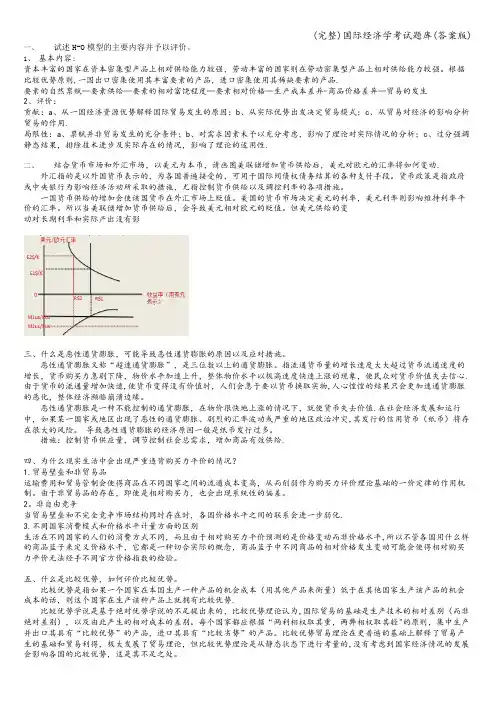
一、试述H-O模型的主要内容并予以评价。
1、基本内容:资本丰富的国家在资本密集型产品上相对供给能力较强,劳动丰富的国家则在劳动密集型产品上相对供给能力较强。
根据比较优势原则,一国出口密集使用其丰富要素的产品,进口密集使用其稀缺要素的产品.要素的自然禀赋—要素供给—要素的相对富饶程度—要素相对价格—生产成本差异-商品价格差异—贸易的发生2、评价:贡献:a、从一国经济资源优势解释国际贸易发生的原因;b、从实际优势出发决定贸易模式;c、从贸易对经济的影响分析贸易的作用.局限性:a、禀赋并非贸易发生的充分条件;b、对需求因素未予以充分考虑,影响了理论对实际情况的分析;c、过分强调静态结果,排除技术进步及实际存在的情况,影响了理论的适用性.二、结合货币市场和外汇市场,以美元为本币,请画图美联储增加货币供给后,美元对欧元的汇率将如何变动.外汇指的是以外国货币表示的,为各国普遍接受的,可用于国际间债权债务结算的各种支付手段。
货币政策是指政府或中央银行为影响经济活动所采取的措施,尤指控制货币供给以及调控利率的各项措施。
一国货币供给的增加会使该国货币在外汇市场上贬值。
美国的货币市场决定美元的利率,美元利率则影响维持利率平价的汇率。
所以当美联储增加货币供给后,会导致美元相对欧元的贬值。
但美元供给的变动对长期利率和实际产出没有影三、什么是恶性通货膨胀,可能导致恶性通货膨胀的原因以及应对措施。
恶性通货膨胀又称“超速通货膨胀”,是三位数以上的通货膨胀。
指流通货币量的增长速度大大超过货币流通速度的增长,货币购买力急剧下降,物价水平加速上升,整体物价水平以极高速度快速上涨的现象,使民众对货币价值失去信心.由于货币的流通量增加快速,使货币变得没有价值时,人们会急于要以货币换取实物,人心惶惶的结果只会更加速通货膨胀的恶化,整体经济濒临崩溃边缘。
恶性通货膨胀是一种不能控制的通货膨胀,在物价很快地上涨的情况下,就使货币失去价值.在社会经济发展和运行中,如果某一国家或地区出现了恶性的通货膨胀、剧烈的汇率波动或严重的地区政治冲突,其发行的信用货币(纸币)将存在很大的风险。
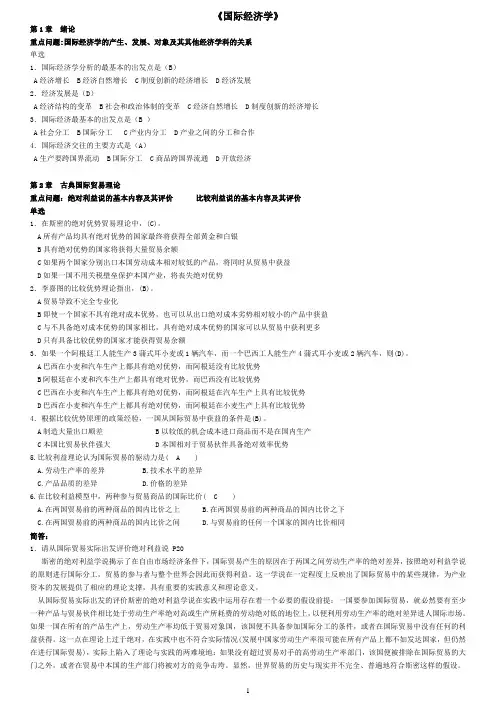
第1章绪论重点问题:国际经济学的产生、发展、对象及其其他经济学科的关系单选1.国际经济学分析的最基本的出发点是(B)A经济增长 B经济自然增长 C制度创新的经济增长 D经济发展2.经济发展是(D)A经济结构的变革 B社会和政治体制的变革 C经济自然增长 D制度创新的经济增长3.国际经济最基本的出发点是(B )A社会分工 B国际分工 C产业内分工 D产业之间的分工和合作4.国际经济交往的主要方式是(A)A生产要跨国界流动 B国际分工 C商品跨国界流通 D开放经济第2章古典国际贸易理论重点问题:绝对利益说的基本内容及其评价比较利益说的基本内容及其评价单选1.在斯密的绝对优势贸易理论中,(C)。
A所有产品均具有绝对优势的国家最终将获得全部黄金和白银B具有绝对优势的国家将获得大量贸易余额C如果两个国家分别出口本国劳动成本相对较低的产品,将同时从贸易中获益D如果一国不用关税壁垒保护本国产业,将丧失绝对优势2.李嘉图的比较优势理论指出,(B)。
A贸易导致不完全专业化B即使一个国家不具有绝对成本优势,也可以从出口绝对成本劣势相对较小的产品中获益C与不具备绝对成本优势的国家相比,具有绝对成本优势的国家可以从贸易中获利更多D只有具备比较优势的国家才能获得贸易余额3.如果一个阿根廷工人能生产3蒲式耳小麦或1辆汽车,而一个巴西工人能生产4蒲式耳小麦或2辆汽车,则(D)。
A巴西在小麦和汽车生产上都具有绝对优势,而阿根廷没有比较优势B阿根廷在小麦和汽车生产上都具有绝对优势,而巴西没有比较优势C巴西在小麦和汽车生产上都具有绝对优势,而阿根廷在汽车生产上具有比较优势D巴西在小麦和汽车生产上都具有绝对优势,而阿根廷在小麦生产上具有比较优势4.根据比较优势原理的政策经验,一国从国际贸易中获益的条件是(B)。
A制造大量出口顺差 B以较低的机会成本进口商品而不是在国内生产C本国比贸易伙伴强大 D本国相对于贸易伙伴具备绝对效率优势5.比较利益理论认为国际贸易的驱动力是( A )A.劳动生产率的差异B.技术水平的差异C.产品品质的差异D.价格的差异6.在比较利益模型中,两种参与贸易商品的国际比价( C )A.在两国贸易前的两种商品的国内比价之上B.在两国贸易前的两种商品的国内比价之下C.在两国贸易前的两种商品的国内比价之间D.与贸易前的任何一个国家的国内比价相同简答:1.请从国际贸易实际出发评价绝对利益说 P20斯密的绝对利益学说揭示了在自由市场经济条件下,国际贸易产生的原因在于两国之间劳动生产率的绝对差异,按照绝对利益学说的原则进行国际分工,贸易的参与者与整个世界会因此而获得利益。
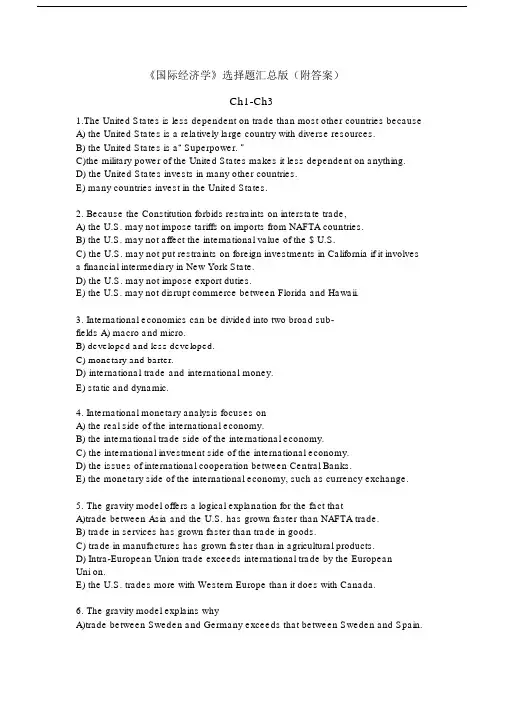
《国际经济学》选择题汇总版(附答案)Ch1-Ch31.The United States is less dependent on trade than most other countries becauseA)the United States is a relatively large country with diverse resources.B)the United States is a“ Superpower. ”C)the military power of the United States makes it less dependent on anything.D)the United States invests in many other countries.E)many countries invest in the United States.2. Because the Constitution forbids restraints on interstate trade,A)the U.S. may not impose tariffs on imports from NAFTA countries.B)the U.S. may not affect the international value of the $ U.S.C)the U.S. may not put restraints on foreign investments in California if it involves a financial intermediary in New York State.D)the U.S. may not impose export duties.E)the U.S. may not disrupt commerce between Florida and Hawaii.3.International economics can be divided into two broad sub-fields A) macro and micro.B) developed and less developed.C) monetary and barter.D) international trade and international money.E) static and dynamic.4.International monetary analysis focuses onA)the real side of the international economy.B)the international trade side of the international economy.C)the international investment side of the international economy.D)the issues of international cooperation between Central Banks.E)the monetary side of the international economy, such as currency exchange.5.The gravity model offers a logical explanation for the fact thatA)trade between Asia and the U.S. has grown faster than NAFTA trade.B) trade in services has grown faster than trade in goods.C) trade in manufactures has grown faster than in agricultural products.D) Intra-European Union trade exceeds international trade by the EuropeanUni on.E) the U.S. trades more with Western Europe than it does with Canada.6.The gravity model explains whyA)trade between Sweden and Germany exceeds that between Sweden and Spain.B)countries with oil reserves tend to export oil.C)capital rich countries export capital intensive products.D)intra-industry trade is relatively more important than other forms of tradebetween neighboringcountries.E)European countries rely most often on natural resources.7. Why does the gravity model work?A)Large economies became large because they were engaged in international trade.B)Large economies have relatively large incomes, and hence spend more on governm ent promotion of trade and investment.C)Large economies have relatively larger areas which raises the probability that a pro ductive activity will take place within the borders of that country.D)Large economies tend to have large incomes and tend to spend more on impor ts.E) Large economies tend to avoid trading with small economies.8.We see that the Netherlands, Belgium, and Ireland trade considerably more with the United States than with many other countries.A)This is explained by the gravity model, since these are all large countries.B)This is explained by the gravity model, since these are all small countries.C)This fails to be consistent with the gravity model, since these are smallcountri es.D)This fails to be consistent with the gravity model, since these are large countries.E)This is explained by the gravity model, since they do not share borders.9.In the present, most of the exports from Chinaare A) manufactured goods.B) services.C)primary products including agricultural.D) technology intensive products.E) overpriced by world market standards.10.A country engaging in trade according to the principles of comparative advantage gains from trade because itA) is producing exports indirectly more efficiently than it could alternatively.B) is producing imports indirectly more efficiently than it could domestically.C) is producing exports using fewer labor units.D) is producing imports indirectly using fewer labor units.E) is producing exports while outsourcing services.11.The Ricardian model attributes the gains from trade associated with the principle o f comparative advantage result toA) differences in technology.B)differences in preferences.C)differences in labor productivity.D)differences in resources.E)gravity relationships among countries.12. A nation engaging in trade according to the Ricardian model will find itsconsump tion bundleA)inside its production possibilities frontier.B)on its production possibilities frontier.C)outside its production possibilities frontier.D)inside its trade-partner's production possibilities frontier.E)on its trade-partner's production possibilities frontier.13.Assume that labor is the only factor of production and that wages in the United Sta tes equal $20 per hour while wages in Japan are $10 per hour. Production costs would be lower in the United States as compared to Japan ifA)U.S. labor productivity equaled 40 units per hour and Japan's 15 units per hour.B)U.S. labor productivity equaled 30 units per hour and Japan's 20 units per hour.C)U.S. labor productivity equaled 20 units per hour and Japan's 30 units per hour.D)U.S. labor productivity equaled 15 units per hour and Japan's 25 units per hour.E)U.S. labor productivity equaled 15 units per hour and Japan's 40 units per hour.14.In a two-country, two-product world, the statement“ Germanyenjoys acomparativ e advantage over France in autos relative toships ”is equivalent toA) France having a comparative advantage over Germany in ships.B) France having a comparative disadvantage compared to Germany in autos and ship s.C) Germany having a comparative advantage over France in autos and ships.D) France having no comparative advantage over Germany.E) France should produce autos.15.If the United States' production possibility frontier was flatter to the widget axis, whereas Germany's was flatter to the butter axis, we know thatA)the United States has no comparative advantageB)Germany has a comparative advantage in butter.C)the U.S. has a comparative advantage in butter.D)Germany has comparative advantages in both products.E)the U.S. has a comparative disadvantage in widgets.Ch4-Ch51.The Ricardian model of international trade demonstrates that trade can bemutually beneficial. Why, then, do governments restrict imports of some goods?A)Trade can have substantial effects on a country's distribution of income.B)The Ricardian model is often incorrect in its prediction that trade can bemutually beneficial.C)Import restrictions are the result of trade wars between hostile countries.D)Imports are only restricted when foreign-made goods do not meet domestic standar ds of qualityE) Restrictions on imports are intended to benefit domestic consumers.2.Japan's trade policies with regard to rice reflect the fact thatA) japanese rice farmers have significant political power.B) Japan has a comparative advantage in rice production and therefore exports most o f its rice crop.C) there would be no gains from trade available to Japan if it engaged in free trade in r ice.D) there are gains from trade that Japan captures by engaging in free trade in rice.E) Japan imports most of the rice consumed in the country.3.In the specific factors model, which of the following is treated as a specific factor?A)LaborB)LandC)ClothD)FoodE)Technology4.The specific factors model assumes that there are ________ goods and ________ fa ctor(s) of production.A) two; threeB) two; two C)two; one D)three; two E)four; three5.The slope of a country's production possibility frontier with cloth measured on the horizontal and food measured on the vertical axis in the specific factors model is equa l to ________ and it ________ as more cloth is produced.A)-MPLF/MPLC; becomes steeperB)-MPLF/MPLC; becomes flatterC)-MPLF/MPLC; is constantD)-MPLC/MPLF; becomes steeperE)-MPLC/MPLF; is constant6.Under perfect competition, the equilibrium price of labor used to produce clothwill be equal toA)the slope of the production possibility frontier.B)the average product of labor in the production of cloth times the price of cloth.C)the ratio of the marginal product of labor in the production of cloth to the marginal product of labor in the production of food times the ratio of the price of cloth. to the price of food.D)the marginal product of labor in the production of cloth times the price of cloth.E)the price of cloth divided by the marginal product of labor in the production of clot h.7.In the specific factors model, which of the following will increase the quantity ofla bor used in cloth production?A)an increase in the price of cloth relative to that of foodB) an increase in the price of food relative to that ofcloth C) a decrease in the price of laborD) an equal percentage decrease in the price of food and clothE) an equal percentage increase in the price of food and cloth8.A country that does not engage in trade can benefit from trade only ifA)it has an absolute advantage in at least one good.B)it employs a unique technology.C)pre-trade and free-trade relative prices are not identical.D)its wage rate is below the world average.E)pre-trade and free-trade relative prices are identical.9.In the specific factors model, the effects of trade on welfare are ________ for mobil e factors, ________ for fixed factors used to produce the exported good, and ________ for fixed factors used to produce the imported good.A)ambiguous; positive; negativeB) ambiguous; negative; positive C)positive; ambiguous; ambiguous D)negative; ambiguous; ambiguous E)positive; positive; positive10.The effect of trade on specialized employees of import-competing industries willb e ________ jobs and ________ pay because they are relatively ________.A)fewer; lower; mobileB)fewer; lower; immobileC)more; lower; immobileD)more; higher; mobileE)more; higher; immobile11. There is a bias in the political process against free trade becauseA)there is a high correlation between the volume of imports and the unemployment ra te.B)the gains from free trade cannot be measured.C)those who gain from free trade can't compensate those who lose.D)foreign governments make large donations to U.S. political campaigns.E) those who lose from free trade are better organized than those who gain.12.In the 2-factor, 2 good Heckscher-Ohlin model, the two countries differin A)tastes and preferences.B)military capabilities.C)the size of their economies.D)relative abundance of factors of production.E)labor productivities.13.If a country produces good Y (measured on the vertical axis) and good X (measure d on the horizontal axis), then the absolute value of the slope of its production possibil ity frontier is equal toA)the opportunity cost of good X.B) the price of good X divided by the price of good Y.C) the price of good X divided by the price of goodY. D) the opportunity cost of good Y.E)the cost of capital (assuming that good Y is capital intensive) divided by the costof labor.14.In the 2-factor, 2 good Heckscher-Ohlin model, trade will ________ the owners ofa country's ________ factor and will ________ the good that uses that factor intensiv ely.A)benefit; abundant; exportB)harm; abundant; importC)benefit; scarce; exportD)benefit; scarce; importE)harm; scarce; export15.The assumption of diminishing returns in the Heckscher-Ohlin model means that, unlike in the Ricardian model, it is likely thatA) countries will consume outside their production possibility frontier.B) countries will benefit from free international trade.C) countries will not be fully specialized in one product.D)comparative advantage will not determine the direction of trade.E)global production will decrease under trade.16.If Japan is relatively capital rich and the United States is relatively land rich, and if food is relatively land intensive then trade between these two, formerly autarkic coun tries will result inA)an increase in the relative price of food in the U.S.B)an increase in the relative price of food in Japan.C)a global increase in the relative price of food.D)a decrease in the relative price of food in both countries.E)an increase in the relative price of food in both countries.17.Starting from an autarky (no-trade) situation with Heckscher-Ohlin model, if Coun try H is relatively labor abundant, then once trade beginsA) rent will be unchanged but wages will rise in H.B) wages and rents should rise in H.C) wages and rents should fall in H.D) wages should fall and rents should rise in H.E) wages should rise and rents should fall in H.18.The Leontieff ParadoxA)failed to support the validity of the Heckscher-Ohlin model.B)supported the validity of the Ricardian theory of comparative advantage.C)supported the validity of the Heckscher-Ohlin model.D)failed to support the validity of the Ricardian theory.E)proved that the U.S. economy is different from all others.19. Which of the following is an assertion of the Heckscher-Ohlin model?A)Factor price equalization will occur only if there is costless mobility of all factors a cross borders.B)An increase in a country's labor supply will increase production of both the capital-intensive and the labor-intensive good.C)In the long-run, labor is mobile and capital is not.D)The wage-rental ratio determines the capital-labor ratio in a country's industr ies.E)Factor endowments determine the technology that is available to a country, which determines the good in which the country will have a comparative advantage.20. Which of the following is an assertion of the Heckscher-Ohlin model?A)An increase in a country's labor supply will increase production of the labor-i ntensive good and decrease production of the capital-intensive good.B)An increase in a country's labor supply will increase production of both the capital-intensive and the labor-intensive good.C)In the long-run, labor is mobile and capital is not.D)Factor price equalization will occur only if there is costless mobility of all factors a cross borders.E)Factor endowments determine the technology that is available to a country, which determines the good in which the country will have a comparative advantage.Ch6-Ch101.If the ratio of price of cloth (PC) divided by the price of food (PF) increases in thei nternational marketplace, thenA)the terms of trade of cloth exporters will improve.B)all countries would be better off.C)the terms of trade of food exporters will improve.D)the terms of trade of all countries will improve.E) the terms of trade of cloth exporters will worsen.2.If the ratio of price of cloth (PC) divided by the price of food (PF) increases in thei nternational marketplace, thenA)world relative quantity of cloth supplied will increase.B)world relative quantity of cloth supplied and demanded will increase.C)world relative quantity of cloth supplied and demanded will decrease.D)world relative quantity of cloth demanded will decrease.E)world relative quantity of food will increase.3.If the U.S. (a large country) imposes a tariff on its imported good, this will tend toA)have no effect on terms of trade.B)improve the terms of trade of the United States.C)improve the terms of trade of all countries.D)because a deterioration of U.S. terms of trade.E)raise the world price of the good imported by the United States.4.If Slovenia were a large country in world trade, then if it instituted a large set of sub sidies for its exports, this mustA)decrease its marginal propensity to consume.B)have no effect on its terms of trade.C)improve its terms of trade.D)harm its terms of trade.E)harm world terms of trade.5.Internal economies of scale arise when the cost per unitA)falls as the average firm grows larger.B)rises as the industry grows larger.C)falls as the industry grows larger.D)rises as the average firm grows larger.E)remains constant over a broad range of output.6. External economies of scale will ________ average cost when output is ________ by _______.A)reduce; increased; the industryB)reduce; increased; a firmC)increase; increased; a firmD)increase; increased; the industryE)reduce; reduce; the industry7.If some industries exhibit internal increasing returns to scale in each country, we sh ould not expect to seeA) perfect competition in these industries.B) intra-industry trade between countries.C)inter-industry trade between countries.D)high levels of specialization in both countries.E)increased productivity in both countries.8.A learning curve relates ________ to ________ and is a case of ________ returns.A) unit cost; cumulative production; dynamic decreasing returnsB)output per time period; long-run marginal cost; dynamic increasing returnsC)unit cost; cumulative production; dynamic increasing returnsD)output per time period; long-run marginal cost; dynamic decreasing returnsE)labor productivity; education; increasing marginal returns9.Patterns of interregional trade are primarily determined by ________ rather than __ ______ because factors of production are generally ________.A)external economies; natural resources; mobileB)internal economies; external economies; mobileC)external economies; population; immobileD)internal economies; population; immobileE)population; external economies; immobile10.Monopolistic competition is associatedwith A) product differentiation.B) price-taking behavior.C) explicit consideration at the firm level of the strategic impact of other firms' pricing decisions. D) high profit margins in the long run.E) increasing returns to scale.11.A firm in long-run equilibrium under monopolistic competition will earnA)positive monopoly profits because each sells a differentiated product.B)zero economic profits because of free entryC)positive oligopoly profits because each firm sells a differentiated product.D)negative economic profits because it has economies of scale.E)positive economic profit if it engages in international trade.12.The most common form of price discrimination in international tradeis A) dumping.B) non-tariff barriers.C) Voluntary Export Restraints.D) preferential trade arrangements.E) product boycotts.13.Consider the following two cases. In the first, a U.S. firm purchases 18% of a forei gn firm. In the second, a U.S. firm builds a new production facility in a foreign countr y. Both are ________, with the first referred to as ________ and the second as ______ __.A)foreign direct investment (FDI) outflows; brownfield; greenfieldB)foreign direct investment (FDI) inflows; greenfield; brownfieldC)foreign direct investment (FDI) outflows; greenfield; brownfieldD)foreign direct investment (FDI) inflows; brownfield; greenfieldE)foreign direct investment (FDI); inflows; outflows14. Specific tariffs areA)import taxes stated in specific legal statutes.B)import taxes calculated as a fixed charge for each unit of imported goods.C)import taxes calculated as a fraction of the value of the imported goods.D)the same as import quotas.E)import taxes calculated based solely on the origin country.15.A problem encountered when implementing an "infant industry" tariff isthat A) domestic consumers will purchase the foreign good regardless of thetariff. B) the industry may never "mature."C)most industries require tariff protection when they are mature.D)the tariff may hurt the industry's domestic sales.E)the tariffs fail to protect the domestic producers.16.In the country levying the tariff, the tariff will A)increase both consumer and producer surplus.B) decrease both the consumer and producer surplus.C) decrease consumer surplus and increase producer surplus.D) increase consumer surplus and decrease producer surplus.E) decrease consumer surplus but leave producers surplus unchanged.17.If the tariff on computers is not changed, but domestic computer producers shift fr om domestically produced semiconductors to imported components, then the effective rate of protection in the computer industry willA) increase.B) decreaseC) remain the same.D)depend on whether computers are PCs or "Supercomputers."E)no longer apply.18.When a government allows raw materials and other intermediate products to enter a country duty free, this generally results in a(an)A) effective tariff rate less than the nominal tariff rate.B) nominal tariff rate less than the effective tariff rate.C) rise in both nominal and effective tariff rates.D) fall in both nominal and effective tariff rates. E) rise in only the effective tariff rat e.19.Should the home country be "large" relative to its trade partners, its imposition ofa tariff on imports would lead to an increase in domestic welfare if the terms of thetra de rectangle exceed the sum of theA) revenue effect plus redistribution effect.B) protective effect plus revenue effect.C) consumption effect plus redistribution effect.D)production distortion effect plus consumption distortion effect.E)terms of trade gain.20.The efficiency case made for free trade is that as trade distortions such as tariffs ar e dismantledand removed,A) government tariff revenue will decrease, and therefore national economic welfare will decreaseB) government tariff revenue will decrease, and therefore national econo mic welfare will increase.C) deadweight losses for producers and consumers will decrease, henceincreasin g national economic welfare.D)deadweight losses for producers and consumers will decrease, hence decreasing na tional economic welfare.E)government tariff revenue will increase, hence increasing national economic welfar e.21.Which organization determines procedures for the settlement of international trade disputes?A)World BankB)World Trade OrganizationC)International Monetary OrganizationD)International Bank for Reconstruction and DevelopmentE)The League of Nations22.Today U.S. protectionism is concentratedin A) high-tech industries.B) labor-intensive industries.C) industries in which Japan has a comparative advantage.D)computer intensive industries.E)capital-intensive industries.23.The quantitative importance of U.S. protection of the domestic clothing industryis best explained by the fact thatA)this industry is an important employer of highly skilled labor.B)this industry is an important employer of low skilled labor.C)most of the exporters of clothing into the U.S. are poor countries.D)this industry is a politically well organized sector in the U.S.E)the technology involved is very advanced.欢迎下载1124.The optimum tariff is most likely to applyto A) a small tariff imposed by a small country.B) a small tariff imposed by a large country. C)a large tariff imposed by a small country. D) alarge tariff imposed by a large country. E) anad valorem tariff on a small country.25.The median voter modelA)works well in the area of trade policy.B)is not intuitively reasonable.C)tends to result in biased tariff rates.D)does not work well in the area of trade policy.E)is not widely practiced in the United States.欢迎下载12。
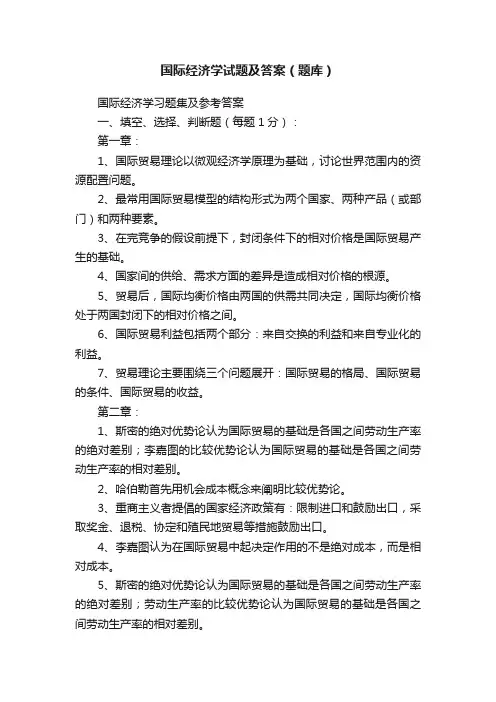
国际经济学试题及答案(题库)国际经济学习题集及参考答案一、填空、选择、判断题(每题1分):第一章:1、国际贸易理论以微观经济学原理为基础,讨论世界范围内的资源配置问题。
2、最常用国际贸易模型的结构形式为两个国家、两种产品(或部门)和两种要素。
3、在完竞争的假设前提下,封闭条件下的相对价格是国际贸易产生的基础。
4、国家间的供给、需求方面的差异是造成相对价格的根源。
5、贸易后,国际均衡价格由两国的供需共同决定,国际均衡价格处于两国封闭下的相对价格之间。
6、国际贸易利益包括两个部分:来自交换的利益和来自专业化的利益。
7、贸易理论主要围绕三个问题展开:国际贸易的格局、国际贸易的条件、国际贸易的收益。
第二章:1、斯密的绝对优势论认为国际贸易的基础是各国之间劳动生产率的绝对差别;李嘉图的比较优势论认为国际贸易的基础是各国之间劳动生产率的相对差别。
2、哈伯勒首先用机会成本概念来阐明比较优势论。
3、重商主义者提倡的国家经济政策有:限制进口和鼓励出口,采取奖金、退税、协定和殖民地贸易等措施鼓励出口。
4、李嘉图认为在国际贸易中起决定作用的不是绝对成本,而是相对成本。
5、斯密的绝对优势论认为国际贸易的基础是各国之间劳动生产率的绝对差别;劳动生产率的比较优势论认为国际贸易的基础是各国之间劳动生产率的相对差别。
6、在李嘉图模型中,生产可能性边界线方程是一个线性方程式,表示A、B两国的PPF曲线是一条直线段。
7、重商主义者提倡的国家经济政策有:限制进口和鼓励出口,采取奖金、退税、协定和殖民地贸易等措施鼓励出口。
8、李嘉图认为在国际贸易中起决定作用的不是绝对成本,而是相对成本。
9、机会成本概念表明:彼种选择的机会成本就构成此种选择的机会成本。
选择题:1、首先用机会成本理论来解释比较优势原理的学者是: C、A、李嘉图B、罗布津斯基C、哈伯勒D、穆勒第三章:1、要素禀赋理论最初是由赫克歇尔和俄林提出的,后经萨缪尔森等人加工不断完善。
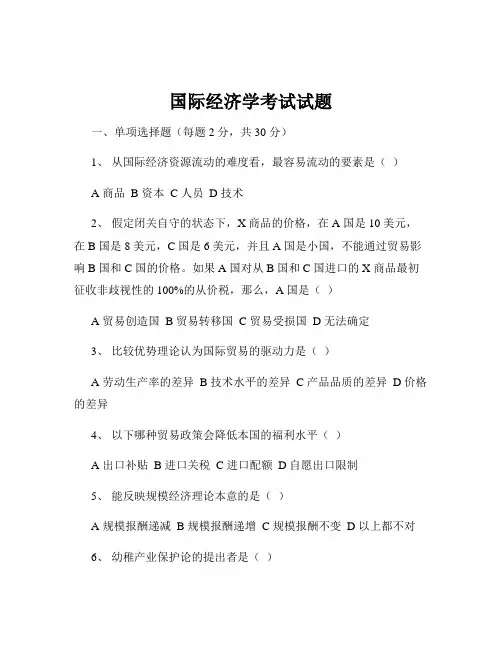
国际经济学考试试题一、单项选择题(每题 2 分,共 30 分)1、从国际经济资源流动的难度看,最容易流动的要素是()A 商品B 资本C 人员D 技术2、假定闭关自守的状态下,X 商品的价格,在 A 国是 10 美元,在 B 国是 8 美元,C 国是 6 美元,并且 A 国是小国,不能通过贸易影响 B 国和 C 国的价格。
如果 A 国对从 B 国和 C 国进口的 X 商品最初征收非歧视性的 100%的从价税,那么,A 国是()A 贸易创造国B 贸易转移国C 贸易受损国D 无法确定3、比较优势理论认为国际贸易的驱动力是()A 劳动生产率的差异B 技术水平的差异C 产品品质的差异D 价格的差异4、以下哪种贸易政策会降低本国的福利水平()A 出口补贴B 进口关税C 进口配额D 自愿出口限制5、能反映规模经济理论本意的是()A 规模报酬递减B 规模报酬递增C 规模报酬不变D 以上都不对6、幼稚产业保护论的提出者是()A 亚当·斯密B 大卫·李嘉图C 汉密尔顿D 李斯特7、当一国政府对某种产品征收进口关税时,若该产品的需求弹性大于供给弹性,生产者与消费者承担关税的程度是()A 前者大于后者B 后者大于前者C 两者相等D 不确定8、一国货币贬值对其进出口收支产生何种影响()A 出口增加,进口减少B 出口减少,进口增加C 出口增加,进口增加D 出口减少,进口减少9、在浮动汇率制下,当一国国际收支出现逆差时,该国货币汇率会()A 上升B 下降C 不变D 不确定10、以下哪项不是国际收支平衡表中的项目()A 经常项目B 资本项目C 错误与遗漏项目D 国内生产总值项目11、购买力平价理论的基础是()A 一价定律B 利率平价C 相对购买力平价D 绝对购买力平价12、国际收支调整的弹性分析法的假设前提不包括()A 不存在国际资本流动B 汇率由货币当局决定C 马歇尔勒纳条件成立D 进出口商品的供给弹性无穷大13、下列属于直接标价法的是()A 1 美元=68 人民币B 1 人民币=015 美元C 1 英镑=12 欧元D 1 欧元=085 英镑14、蒙代尔弗莱明模型主要分析在资本完全流动的情况下,()政策的有效性。
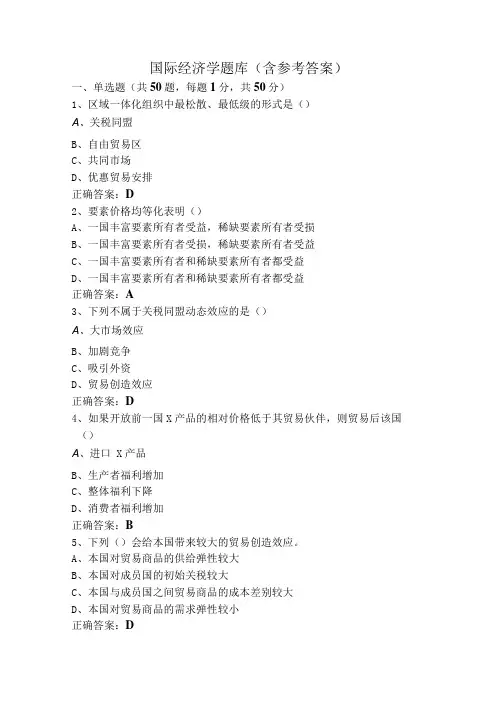
国际经济学题库(含参考答案)一、单选题(共50题,每题1分,共50分)1、区域一体化组织中最松散、最低级的形式是()A、关税同盟B、自由贸易区C、共同市场D、优惠贸易安排正确答案:D2、要素价格均等化表明()A、一国丰富要素所有者受益,稀缺要素所有者受损B、一国丰富要素所有者受损,稀缺要素所有者受益C、一国丰富要素所有者和稀缺要素所有者都受益D、一国丰富要素所有者和稀缺要素所有者都受益正确答案:A3、下列不属于关税同盟动态效应的是()A、大市场效应B、加剧竞争C、吸引外资D、贸易创造效应正确答案:D4、如果开放前一国X产品的相对价格低于其贸易伙伴,则贸易后该国()A、进口 X产品B、生产者福利增加C、整体福利下降D、消费者福利增加正确答案:B5、下列()会给本国带来较大的贸易创造效应。
A、本国对贸易商品的供给弹性较大B、本国对成员国的初始关税较大C、本国与成员国之间贸易商品的成本差别较大D、本国对贸易商品的需求弹性较小正确答案:D6、初级产品的出口价格若下降,其出口量将增加,出口总收入()A、不变B、增加C、下降D、不确定正确答案:C7、马歇尔一勒纳条件所要说明的是在供给弹性()的情况下,本币贬值能够改善贸易收支的进出口需求弹性条件。
A、零B、无穷大C、1D^大于零小于1正确答案:B8、假设中国和美国都能生产小麦和布,中国将一单位劳动时间全部生产布,可以生产50米;全部生产小麦,可以生产80千克;美国将一单位劳动时间全部生产布,可以生产40米;全部生产小麦,可以生产 100千克。
如果开放后的国际交换比价为1米布=L 8千克小麦,则下列说法正确的是()A、无法比较美国和中国的获利情况B、中国从贸易开放中获利更多C、美国和中国从贸易开放中获利相同D、美国从贸易开放中获利更多正确答案:D9、下列不属于国际收支平衡表资本项目的是()A、利息收支B、短期信贷C、短期证券买卖D、票据买卖正确答案:A10、消费者剩余是()A、消费者为了商品的消费而必须向政府支付的东西B、消费者通过低于市场价格的价格而得到的收益C、消费者购买商品所需支付的价格低于其愿意支付的价格而获得的收益D、消费者可以在各种价格水平得到的收益正确答案:C11、外汇市场中的即期交易不包含()A、套汇B、投机C、国际贸易结算D、银行同业拆借正确答案:B12、如果一个中国工人能生产3匹布或者1辆汽车,一个美国工人能生产4匹布或2辆汽车,则能促进中国与美国进行贸易并各自收益的交换比率是()A、4匹布换2辆汽车B、3匹布换1辆汽车C、3匹布换2辆汽车D、5匹布换2辆汽车正确答案:D13、国际经济学的研究对象是()A、国际商品流动B、国际收支平衡C、世界范围内的稀缺资源的最优配置D^国际人员流动正确答案:C14、根据国民收入决定方程Y=C+I+G+X-M,国际收支的吸收分析法中的“吸收”是指()A、YB、C+IC、C+I+GD、X-M正确答案:C15、开放经济条件下的宏观经济政策目标是()A、追求贸易顺差B、汇率稳定C、扩大出口D、国际收支平衡正确答案:D16、在进行贸易后,一国的收入分配会发生如下变化,()A、收入由消费者转向生产者B、受到进口商品竞争压力的国内生产者遭受损失,而出口商品的生产者则会受益C、消费者受损,生产者受益D、作为整体的国家受益,而个人则会受到损失正确答案:B17、商品和服务贸易记录在国际收支平衡表中的()A、经常项目B、误差和遗漏项目C、官方结算项目D、资本项目正确答案:A18、下列哪个行业最有可能具有内部规模经济?()A、好莱坞的电影业B、加州硅谷的半导体产业C、美国的大型农场D、北京中关村的电脑城正确答案:C19、采用()的配额分配方式,配额的福利效果与关税一样。
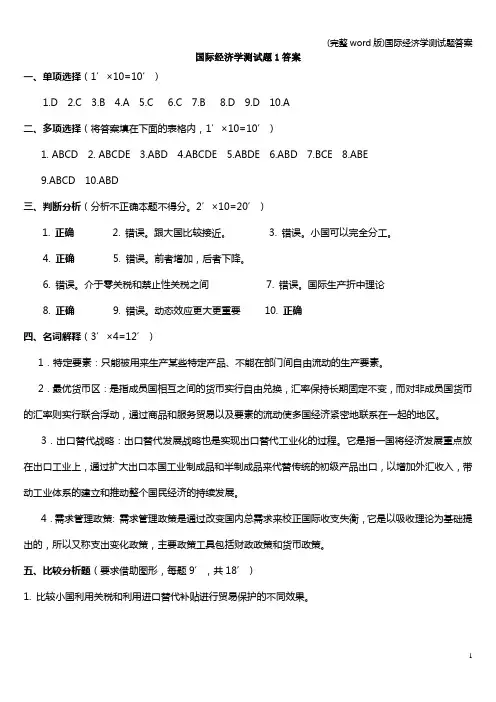
国际经济学测试题1答案一、单项选择(1’×10=10’)1.D2.C3.B4.A5.C6.C7.B8.D9.D 10.A二、多项选择(将答案填在下面的表格内,1’×10=10’)1. ABCD2. ABCDE3.ABD4.ABCDE5.ABDE6.ABD7.BCE8.ABE9.ABCD 10.ABD三、判断分析(分析不正确本题不得分。
2’×10=20’)1. 正确2. 错误。
跟大国比较接近。
3. 错误。
小国可以完全分工。
4. 正确5. 错误。
前者增加,后者下降。
6. 错误。
介于零关税和禁止性关税之间7. 错误。
国际生产折中理论8. 正确9. 错误。
动态效应更大更重要10. 正确四、名词解释(3’×4=12’)1.特定要素:只能被用来生产某些特定产品、不能在部门间自由流动的生产要素。
2.最优货币区:是指成员国相互之间的货币实行自由兑换,汇率保持长期固定不变,而对非成员国货币的汇率则实行联合浮动,通过商品和服务贸易以及要素的流动使多国经济紧密地联系在一起的地区。
3.出口替代战略:出口替代发展战略也是实现出口替代工业化的过程。
它是指一国将经济发展重点放在出口工业上,通过扩大出口本国工业制成品和半制成品来代替传统的初级产品出口,以增加外汇收入,带动工业体系的建立和推动整个国民经济的持续发展。
4.需求管理政策: 需求管理政策是通过改变国内总需求来校正国际收支失衡,它是以吸收理论为基础提出的,所以又称支出变化政策,主要政策工具包括财政政策和货币政策。
五、比较分析题(要求借助图形,每题9’,共18’)1. 比较小国利用关税和利用进口替代补贴进行贸易保护的不同效果。
征收关税之后,该国的总福利水平下降了:消费者剩余损失了(a+b+c+d),其中a被生产者所得,c为政府财政收入所得,但尚有b和d的损失,国内没有任何人能得到相应的补偿。
这是由于关税使本国的生产资源从效率较高的部门转移到了效率较低的部门,即一国的生产资源向没有比较优势的进口竞争部门集中,因此造成了国民福利净损失。
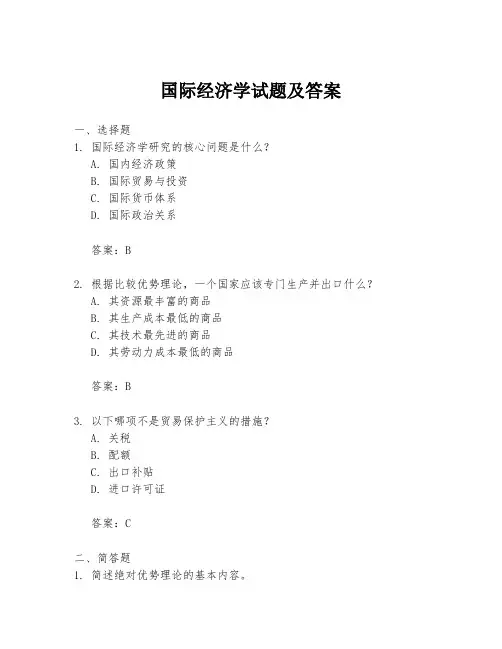
国际经济学试题及答案一、选择题1. 国际经济学研究的核心问题是什么?A. 国内经济政策B. 国际贸易与投资C. 国际货币体系D. 国际政治关系答案:B2. 根据比较优势理论,一个国家应该专门生产并出口什么?A. 其资源最丰富的商品B. 其生产成本最低的商品C. 其技术最先进的商品D. 其劳动力成本最低的商品答案:B3. 以下哪项不是贸易保护主义的措施?A. 关税B. 配额C. 出口补贴D. 进口许可证答案:C二、简答题1. 简述绝对优势理论的基本内容。
答案:绝对优势理论由亚当·斯密提出,主张一个国家应该生产并出口其生产效率最高的商品,进口其生产效率最低的商品。
该理论认为,即使一个国家在所有商品的生产上都没有绝对优势,它仍然可以通过专业化生产效率相对较高的商品来获得贸易利益。
2. 什么是国际收支平衡表?答案:国际收支平衡表是一个记录一个国家与其他国家之间所有经济交易的统计报表。
它包括经常账户、资本和金融账户以及官方储备账户。
经常账户记录商品和服务的交易,资本和金融账户记录资本流动和金融资产的交易,官方储备账户记录中央银行的外汇储备变动。
三、论述题1. 论述汇率变动对国际贸易的影响。
答案:汇率变动对国际贸易有重要影响。
当一个国家的货币升值时,其出口商品在国际市场上的价格上升,竞争力下降,导致出口减少;同时,进口商品的价格下降,国内消费者更倾向于购买外国商品,导致进口增加。
相反,当一个国家的货币贬值时,其出口商品的价格下降,竞争力增强,促进出口;进口商品的价格上升,抑制进口。
此外,汇率变动还会影响跨国公司的投资决策,因为投资成本和收益会随着汇率变动而变化。
2. 分析全球化对发展中国家的影响。
答案:全球化为发展中国家带来了机遇和挑战。
机遇方面,全球化促进了资本、技术和信息的流动,为发展中国家提供了更多的市场机会和投资机会,有助于提高生产效率和经济增长。
挑战方面,全球化加剧了国际竞争,对发展中国家的产业和就业产生压力,可能导致收入差距扩大。
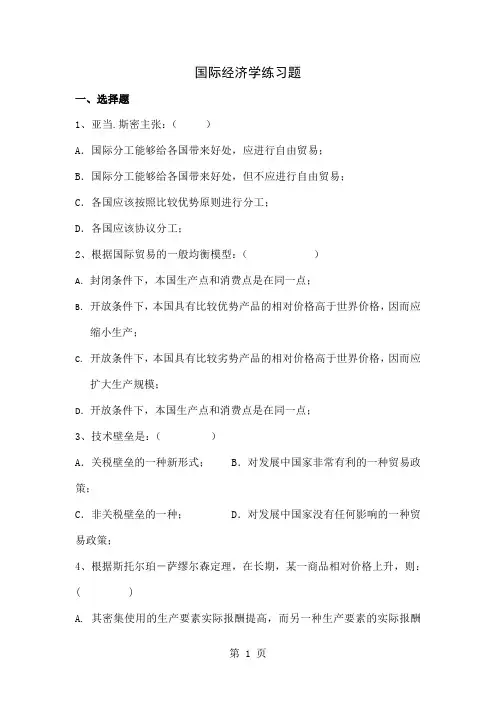
国际经济学练习题一、选择题1、亚当.斯密主张:()A.国际分工能够给各国带来好处,应进行自由贸易;B.国际分工能够给各国带来好处,但不应进行自由贸易;C.各国应该按照比较优势原则进行分工;D.各国应该协议分工;2、根据国际贸易的一般均衡模型:()A.封闭条件下,本国生产点和消费点是在同一点;B.开放条件下,本国具有比较优势产品的相对价格高于世界价格,因而应缩小生产;C.开放条件下,本国具有比较劣势产品的相对价格高于世界价格,因而应扩大生产规模;D.开放条件下,本国生产点和消费点是在同一点;3、技术壁垒是:()A.关税壁垒的一种新形式; B.对发展中国家非常有利的一种贸易政策;C.非关税壁垒的一种; D.对发展中国家没有任何影响的一种贸易政策;4、根据斯托尔珀-萨缪尔森定理,在长期,某一商品相对价格上升,则:( )A. 其密集使用的生产要素实际报酬提高,而另一种生产要素的实际报酬B. 其密集使用的生产要素实际报酬下降,而另一种生产要素的实际报酬也下降;C. 其密集使用的生产要素实际报酬提高,而另一种生产要素的实际报酬也上升;D.其密集使用的生产要素实际报酬下降,而另一种生产要素的实际报酬上升;5、按照国际贸易的一般均衡模型,若横轴表示优势产品,则贸易后的价格曲线会:()A.变得更加平缓,变化越大,本国从国际贸易中得到利益越大;B.变得更加陡峭,变化越大,本国从国际贸易中得到利益越大;C.变得更加平缓,变化越小,本国从国际贸易中得到利益越大;D.变得更加陡峭,变化越小,本国从国际贸易中得到利益越大;6、国际贸易的利益可以分解为:()A.交换所得和消费所得; B.消费所得和生产所得;C.交换所得和分工所得; D.生产所得和消费所得;7、按照购买力平价理论,A国某年度通货膨胀率为15%,B国为5%,若其它条件不变,则A国货币相对B货币的实际汇率:()A.不发生变化;B. 上升; C.下降; D. 无法确定8、经济同盟的建立可以:()A.限制生产要素在成员国之间自由流动;B.限制商品在成员国之间自由C.同WTO的基本主张不一致;D.对成员国的货币和财政政策进行协调致;9、甲国拥有资本500单位,劳动力100单位;乙国拥有资本1500单位,劳动力500单位;按照要素禀赋原理:()A.甲国资本丰裕,乙国劳动力丰裕; B.乙国资本丰裕,甲国劳动力丰裕;C.甲国资本和劳动力都不丰裕; D.甲乙两国在任何生产要素上都不丰裕;10、战略性贸易保护政策:()A.是适用于完全竞争行业的一种贸易政策; B.是一种“以邻为壑”的贸易政策;C.发展中国家可以借鉴和普遍使用; D.是一种“双赢”的贸易政策;11、根据重叠需求理论,()A.两国收入水平差距越小,重叠需求越小,相互之间的贸易关系越密切;B.两国收入水平差距越大,重叠需求越大,相互之间的贸易关系越密切;C.两国收入水平差距越小,重叠需求越大,相互之间的贸易关系越密切;D.两国收入水平差距越大,重叠需求越小,相互之间的贸易关系越密切;12、能够对产业领先地位不断转移现象进行解释的国际贸易理论是:()A. 比较优势理论;B.产品生命周期理论;C.要素禀赋原理;D.重叠需求理论;13、按照罗勃津斯基定理,在商品相对价格不变的情况下,某生产要素的增长()A.会使密集使用该要素的商品生产扩大,使密集使用其他要素的商品生产也扩大。
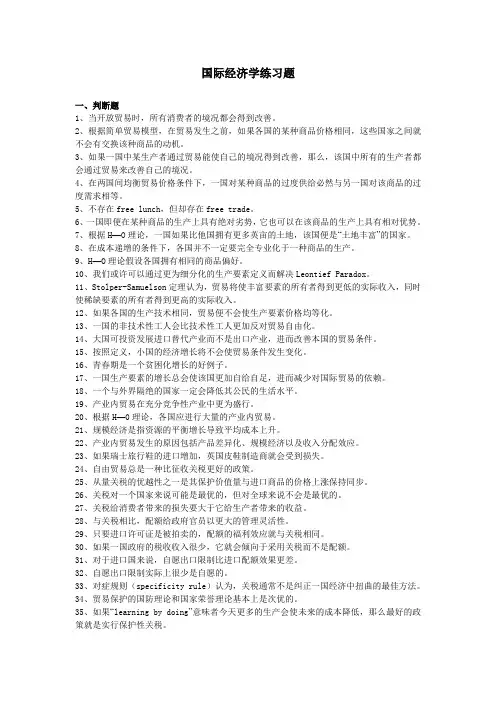
国际经济学练习题一、判断题1、当开放贸易时,所有消费者的境况都会得到改善。
2、根据简单贸易模型,在贸易发生之前,如果各国的某种商品价格相同,这些国家之间就不会有交换该种商品的动机。
3、如果一国中某生产者通过贸易能使自己的境况得到改善,那么,该国中所有的生产者都会通过贸易来改善自己的境况。
4、在两国间均衡贸易价格条件下,一国对某种商品的过度供给必然与另一国对该商品的过度需求相等。
5、不存在free lunch,但却存在free trade。
6、一国即便在某种商品的生产上具有绝对劣势,它也可以在该商品的生产上具有相对优势。
7、根据H—O理论,一国如果比他国拥有更多英亩的土地,该国便是“土地丰富”的国家。
8、在成本递增的条件下,各国并不一定要完全专业化于一种商品的生产。
9、H—O理论假设各国拥有相同的商品偏好。
10、我们或许可以通过更为细分化的生产要素定义而解决Leontief Paradox。
11、Stolper-Samuelson定理认为,贸易将使丰富要素的所有者得到更低的实际收入,同时使稀缺要素的所有者得到更高的实际收入。
12、如果各国的生产技术相同,贸易便不会使生产要素价格均等化。
13、一国的非技术性工人会比技术性工人更加反对贸易自由化。
14、大国可投资发展进口替代产业而不是出口产业,进而改善本国的贸易条件。
15、按照定义,小国的经济增长将不会使贸易条件发生变化。
16、青春期是一个贫困化增长的好例子。
17、一国生产要素的增长总会使该国更加自给自足,进而减少对国际贸易的依赖。
18、一个与外界隔绝的国家一定会降低其公民的生活水平。
19、产业内贸易在充分竞争性产业中更为盛行。
20、根据H—0理论,各国应进行大量的产业内贸易。
21、规模经济是指资源的平衡增长导致平均成本上升。
22、产业内贸易发生的原因包括产品差异化、规模经济以及收入分配效应。
23、如果瑞士旅行鞋的进口增加,英国皮鞋制造商就会受到损失。
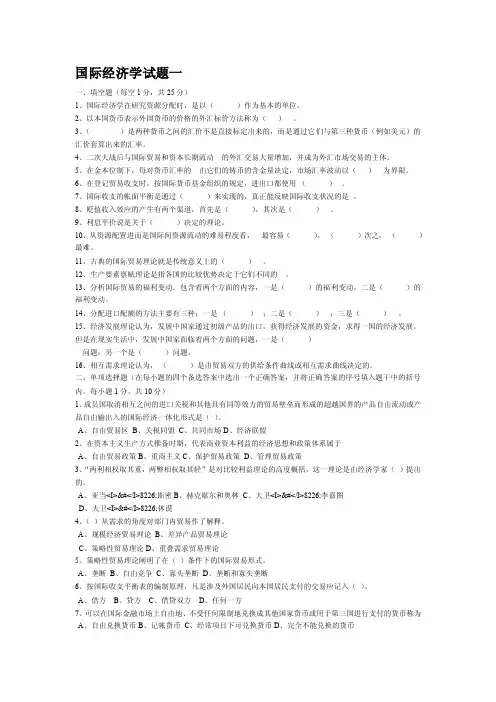
国际经济学试题一一、填空题(每空1分,共25分)1、国际经济学在研究资源分配时,是以()作为基本的单位。
2、以本国货币表示外国货币的价格的外汇标价方法称为()。
3、()是两种货币之间的汇价不是直接标定出来的,而是通过它们与第三种货币(例如美元)的汇价套算出来的汇率。
4、二次大战后与国际贸易和资本长期流动的外汇交易大量增加,并成为外汇市场交易的主体。
5、在金本位制下,每对货币汇率的由它们的铸币的含金量决定,市场汇率波动以()为界限。
6、在登记贸易收支时,按国际货币基金组织的规定,进出口都使用()。
7、国际收支的帐面平衡是通过()来实现的,真正能反映国际收支状况的是。
8、贬值收入效应的产生有两个渠道,首先是(),其次是()。
9、利息平价说是关于()决定的理论。
10、从资源配置进而是国际间资源流动的难易程度看,最容易(),()次之,()最难。
11、古典的国际贸易理论就是传统意义上的()。
12、生产要素禀赋理论是指各国的比较优势决定于它们不同的。
13、分析国际贸易的福利变动.包含着两个方面的内容,一是()的福利变动,二是()的福利变动。
14、分配进口配额的方法主要有三种;一是();二是();三是()。
15、经济发展理论认为,发展中国家通过初级产品的出口,获得经济发展的资金,求得一国的经济发展。
但是在现实生活中,发展中国家面临着两个方面的问题,一是()问题;另一个是()问题。
16、相互需求理论认为,()是由贸易双方的供给条件曲线或相互需求曲线决定的。
二、单项选择题(在每小题的四个备选答案中选出一个正确答案,并将正确答案的序号填入题干中的括号内。
每小题1分,共10分)1、成员国取消相互之间的进口关税和其他具有同等效力的贸易壁垒而形成的超越国界的产品自由流动或产品自由输出入的国际经济一体化形式是()。
A、自由贸易区B、关税同盟C、共同市场D、经济联盟2、在资本主义生产方式推备时期,代表商业资本利益的经济思想和政策体系属于A、自由贸易政策B、重商主义C、保护贸易政策D、管理贸易政策3、“两利相权取其重,两弊相权取其轻”是对比较利益理论的高度概括,这一理论是由经济学家()提出的。
国际经济学测试题1一、单项选择(1’×10=10’)1.重商主义者认为国际贸易()。
A.是一种双赢行为 B. 对其中的强国有利C.对其中的弱国有利 D. 是一种零和行为2.斯密的绝对优势理论假定增加某种产品的生产所放弃的另一种产品生产的代价是()。
A.递增的 B. 递减的C. 不变的D. 不确定的3.如果说一国的资本要素比较丰裕,就意味着()。
A. 该国的资本要素总量较多B. 该国的W/R的值较大C. 该国的K/L的值较小D. 该国的生产中较多使用技术4.根据特定要素模型,国际贸易的受损者为()。
A. 进口竞争部门的特定要素所有者B. 进口竞争部门的流动要素所有者C. 出口部门的特定要素所有者D. 出口部门的流动要素所有者5.根据产品生命周期理论,发明国的新产品出口()。
A. 在产品问世的时候即已开始B. 贯穿整个生命周期C. 是一个先增加然后逐渐减少的过程D. 以上三者都正确6. 在局部均衡分析中,与小国相比,大国征收关税的主要不同在于()。
A. 保护效应更明显B. 消费效应更明显C. 能够改善贸易条件D. 对政府税收没有影响7.如果一国在征收进口税时,对最终产品征收的关税低于中间产品,则可以使关税的实际保护效果()。
A. 增大B. 变小C. 没有影响D. 无法判断8.购买力平价理论的基础是()。
A. 粘性价格的存在B. 货币数量理论C. 马歇尔-勒纳条件D. 一价定律9.根据吸收分析法,贬值一定会()。
A. 导致国内总收入的增加B. 改善国际收支C. 促使国内货币供求重新平衡D. 上述说法都不对10. 根据斯旺图示,用来调节外部均衡的手段是()。
A. 支出转换政策B. 支出调整政策C. 本国的货币政策D. 本国的财政政策二、多项选择(1’×10=10’)1. 能够解释二战以后国际贸易流向新格局的理论包括()。
A.规模经济理论 B. 产业内贸易理论C.产品差异化理论 D. 需求偏好相似理论E.要素禀赋理论2. 对里昂惕夫之谜进行解释的学说包括()。
【国际经济学】英文题库Chapter 1: IntroductionMultiple-Choice Questions1.Which of the following products are not produced at all in the United States? *A. Coffee, tea, cocoaB.steel, copper, aluminumC.petroleum, coal, natural gasD.typewriters, computers, airplanes2.International trade is most important to the standard of living of:A.the United States*B. SwitzerlandC. GermanyD. England3.Over time, the economic interdependence of nations has:*A. grownB.diminishedC.remained unchangedD.cannot say4.A rough measure of the degree of economic interdependence of a nation is give n by:A.the size of the nations' populationB.the percentage of its population to its GDP*C. the percentage of a nation's imports and exports to its GDPD. all of the above5.Economic interdependence is greater for:*A. small nationsrge nationsC.developed nationsD.developing nations6.The gravity model of international trade predicts that trade between two nations is largerA.the larger the two nationsB.the closer the nationsC.the more open are the two nations*D. all of the above7.International economics deals with:A.the flow of goods, services, and payments among nationsB.policies directed at regulating the flow of goods, services, and paymentsC.the effects of policies on the welfare of the nation*D. all of the above8.International trade theory refers to:*A. the microeconomic aspects of international tradeB.the macroeconomic aspects of international tradeC.open economy macroeconomics or international financeD.all of the above9.Which of the following is not the subject matter of international finance?A.foreign exchange marketsB.the balance of payments*C. the basis and the gains from tradeD. policies to adjust balance of payments disequilibria10.Economic theory:A.seeks to explain economic eventsB.seeks to predict economic eventsC.abstracts from the many detail that surrounds an economic event*D. all of the above11.Which of the following is not an assumption generally made in the study of int ernational economics?A.two nationsB.two commodities*C. perfect international mobility of factorsD. two factors of production12.In the study of international economics:A.international trade policies are examined before the bases for tradeB.adjustment policies are discussed before the balance of paymentsC.the case of many nations is discussed before the two-nations case*D. none of the above13.International trade is similar to interregional trade in that both must overcome: *A. distance and spaceB.trade restrictionsC.differences in currenciesD.differences in monetary systems14.The opening or expansion of international trade usually affects all members of s ociety:A.positivelyB.negatively*C. most positively but some negativelyD. most negatively but some positively15.An increase in the dollar price of a foreign currency usually:A. benefit U.S. importers*B. benefits U.S. exportersC. benefit both U.S. importers and U.S. exportersD. harms both U.S. importers and U.S. exporters16.Which of the following statements with regard to international economics is true?A. It is a relatively new field*B. it is a relatively old fieldC. most of its contributors were not economistsD. none of the above思考题:1.为什么学习国际经济学非常重要?2.列举体现当前国际经济学问题的一些重要事件,它们为什么重要?3.当今世界面临的最重要的国家经济问题是什么?全球化的利弊各是什么?Chapter 2: The Law of Comparative AdvantageMultiple-Choice Questions1.The Mercantilists did not advocate:*A.free tradeB.stimulating the nation's exportsC.restricting the nations' importsD.the accumulation of gold by the nation2.According to Adam Smith, international trade was based on:*A. absolute advantageparative advantageC.both absolute and comparative advantageD.neither absolute nor comparative advantage3.What proportion of international trade is based on absolute advantage?A.AllB.most*C. someD. none4.The commodity in which the nation has the smallest absolute disadvantage is the commodity of its:A.absolute disadvantageB.absolute advantageparative disadvantage*D. comparative advantage5.If in a two-nation (A and B), two-commodity (X and Y) world, it is established t hat nation A has a comparative advantage in commodity X, then nation B must hav e:A.an absolute advantage in commodity YB.an absolute disadvantage in commodity YC.a comparative disadvantage in commodity Y*D. a comparative advantage in commodity Y6.If with one hour of labor time nation A can produce either 3X or 3Y while natio n B can produce either 1X or 3Y (and labor is the only input):A.nation A has a comparative disadvantage in commodity XB.nation B has a comparative disadvantage in commodity Y*C. nation A has a comparative advantage in commodity XD. nation A has a comparative advantage in neither commodity7.With reference to the statement in Question 6:A.Px/Py=1 in nation AB.Px/Py=3 in nation BC.Py/Px=1/3 in nation B*D. all of the above8.With reference to the statement in Question 6, if 3X is exchanged for 3Y:A.nation A gains 2X*B. nation B gains 6YC. nation A gains 3YD. nation B gains 3Y9.With reference to the statement of Question 6, the range of mutually beneficial t rade between nation A and B is:A.3Y < 3X < 5YB.5Y < 3X < 9Y*C. 3Y < 3X < 9YD. 1Y < 3X < 3Y10.If domestically 3X=3Y in nation A, while 1X=1Y domestically in nation B:A.there will be no trade between the two nationsB.the relative price of X is the same in both nationsC.the relative price of Y is the same in both nations*D. all of the above11.Ricardo explained the law of comparative advantage on the basis of:*A. the labor theory of valueB.the opportunity cost theoryC.the law of diminishing returnsD.all of the above12.Which of the following statements is true?A.The combined demand for each commodity by the two nations is negatively slop edB.the combined supply for each commodity by the two nations is rising stepwiseC.the equilibrium relative commodity price for each commodity with trade is gi ven by the intersection of the demand and supply of each commodity by the two n ations*D. all of the above13.A difference in relative commodity prices between two nations can be based up on a difference in:A.factor endowmentsB.technologyC.tastes*D. all of the above14.In the trade between a small and a large nation:A. the large nation is likely to receive all of the gains from trade*B. the small nation is likely to receive all of the gains from tradeC. the gains from trade are likely to be equally sharedD. we cannot say15.The Ricardian trade model has been empirically*A. verifiedB.rejectedC.not testedD.tested but the results were inconclusive思考题:比较优势原理所带来的贸易所得是从何而来的?贸易利益又是如何分配的?现实世界中比较优势是如何度量的?你认为目前中国具有比较优势的商品有哪些?这意味着什么?比较优势会不会发生变化?什么样的原因可能会导致其变化?经济学家是如何验证比较优势原理的?Chapter 3: The Standard Theory of International TradeMultiple-Choice Questions1.A production frontier that is concave from the origin indicates that the nation inc urs increasing opportunity costs in the production of:modity X onlymodity Y only*C. both commoditiesD. neither commodity2.The marginal rate of transformation (MRT) of X for Y refers to:A.the amount of Y that a nation must give up to produce each additional unit of XB.the opportunity cost of XC.the absolute slope of the production frontier at the point of production*D. all of the above3.Which of the following is not a reason for increasing opportunity costs:*A. technology differs among nationsB.factors of production are not homogeneousC.factors of production are not used in the same fixed proportion in the production of all commoditiesD.for the nation to produce more of a commodity, it must use resources that are l ess and less suited in the production of the commoditymunity indifference curves:A.are negatively slopedB.are convex to the originC.should not cross*D. all of the above5.The marginal rate of substitution (MRS) of X for Y in consumption refers to the:A.amount of X that a nation must give up for one extra unit of Y and still remain on the same indifference curve*B. amount of Y that a nation must give up for one extra unit of X and still remai n on the same indifference curveC. amount of X that a nation must give up for one extra unit of Y to reach a high er indifference curveD. amount of Y that a nation must give up for one extra unit of X to reach a high er indifference curve6.Which of the following statements is true with respect to the MRS of X for Y?A.It is given by the absolute slope of the indifference curveB.declines as the nation moves down an indifference curveC.rises as the nation moves up an indifference curve*D. all of the above7.Which of the following statements about community indifference curves is true?A.They are entirely unrelated to individuals' community indifference curvesB.they cross, they cannot be used in the analysis*C. the problems arising from intersecting community indifference curves can be ov ercome by the application of the compensation principleD. all of the above.8.Which of the following is not true for a nation that is in equilibrium in isolation? *A. It consumes inside its production frontierB.it reaches the highest indifference curve possible with its production frontierC.the indifference curve is tangent to the nation's production frontierD.MRT of X for Y equals MRS of X for Y, and they are equal to Px/Py9.If the internal Px/Py is lower in nation 1 than in nation 2 without trade:A.nation 1 has a comparative advantage in commodity YB.nation 2 has a comparative advantage in commodity X*C. nation 2 has a comparative advantage in commodity YD. none of the above10.Nation 1's share of the gains from trade will be greater:A. the greater is nation 1's demand for nation 2's exports*B. the closer Px/Py with trade settles to nation 2's pretrade Px/PyC. the weaker is nation 2's demand for nation 1's exportsD. the closer Px/Py with trade settles to nation 1's pretrade Px/Py11.If Px/Py exceeds the equilibrium relative Px/Py with tradeA.the nation exporting commodity X will want to export more of X than at equili briumB.the nation importing commodity X will want to import less of X than at equili briumC.Px/Py will fall toward the equilibrium Px/Py*D. all of the above12.With free trade under increasing costs:A.neither nation will specialize completely in productionB.at least one nation will consume above its production frontierC.a small nation will always gain from trade*D. all of the above13.Which of the following statements is false?A.T he gains from trade can be broken down into the gains from exchange and the gains from specializationB.gains from exchange result even without specialization*C. gains from specialization result even without exchangeD. none of the above14.The gains from exchange with respect to the gains from specialization are alwa ys:A.greaterB.smallerC.equal*D. we cannot say without additional information15.Mutually beneficial trade cannot occur if production frontiers are:A.equal but tastes are notB.different but tastes are the sameC.different and tastes are also different*D. the same and tastes are also the same.思考题:国际贸易的标准理论与大卫.李嘉图的比较优势原理有何异同?两国仅仅由于需求偏好不同可以进行市场分工和狐狸贸易吗?两国仅仅由于要素禀赋不同和/或生产技术不同可以进行分工和贸易吗?Chapter 4: Demand and Supply, Offer Curves, and the Terms of TradeMultiple Choice Questions1.Which of the following statements is correct?A.The demand for imports is given by the excess demand for the commodityB.the supply of exports is given by the excess supply of the commodityC.the supply curve of exports is flatter than the total supply curve of the commodi ty*D. all of the above2.At a relative commodity price above equilibriumA.the excess demand for a commodity exceeds the excess supply of the commodit yB.the quantity demanded of imports exceeds the quantity supplied of exports*C. the commodity price will fallD. all of the above3.The offer curve of a nation shows:A.the supply of a nation's importsB.the demand for a nation's exportsC.the trade partner's demand for imports and supply of exports*D. the nation's demand for imports and supply of exports4.The offer curve of a nation bulges toward the axis measuring the nationsA.import commodity*B. export commodityC. export or import commodityD. nontraded commodity5.Export prices must rise for a nation to increase its exports because the nation:A.incurs increasing opportunity costs in export productionB.faces decreasing opportunity costs in producing import substitutesC.faces decreasing marginal rate of substitution in consumption*D. all of the above6.Which of the following statements regarding partial equilibrium analysis is false?A.It relies on traditional demand and supply curvesB.it isolates for study one market*C. it can be used to determine the equilibrium relative commodity price but not th e equilibrium quantity with tradeD. none of the above7.Which of the following statements regarding partial equilibrium analysis is true?A.The demand and supply curve are derived from the nation's production frontier a nd indifference mapB.It shows the same basic information as offer curvesC.It shows the same equilibrium relative commodity prices as with offer curves*D. all of the above8.In what way does partial equilibrium analysis differ from general equilibrium anal ysis?A.The former but not the latter can be used to determine the equilibrium price wit h tradeB.the former but not the latter can be used to determine the equilibrium quantitywith tradeC.the former but not the latter takes into consideration the interaction among all markets in the economy*D. the former gives only an approximation to the answer sought.9.If the terms of trade of a nation are 1.5 in a two-nation world, those of the trade partner are:A. 3/4*B. 2/3C. 3/2D. 4/310.If the terms of trade increase in a two-nation world, those of the trade partner :*A. deteriorateB.improveC.remain unchangedD.any of the above11.If a nation does not affect world prices by its trading, its offer curve:A.is a straight lineB.bulges toward the axis measuring the import commodity*C. intersects the straight-line segment of the world's offer curveD. intersects the positively-sloped portion of the world's offer curve12.If the nation's tastes for its import commodity increases:A.the nation's offer curve rotates toward the axis measuring its import commodityB.the partner's offer curve rotates toward the axis measuring its import commodityC.the partner's offer curve rotates toward the axis measuring its export commodity *D. the nation's offer curve rotates toward the axis measuring its export commodity13.If the nation's tastes for its import commodity increases:A. the nation's terms of trade remain unchanged*B. the nation's terms of trade deteriorateC. the partner's terms of trade deteriorateD. any of the above14.If the tastes for a nation import commodity increases, trade volume:*A. increasesB.declinesC.remains unchangedD.any of the above15.A deterioration of a nation's terms of trade causes the nation's welfare to:A.deteriorateB.improveC.remain unchanged*D. any of the above思考题:提供曲线如何推导?有何用途?两国贸易时的均衡商品价格是如何决定的?受哪些因素影响?贸易条件的含义是?贸易条件的改善意味着什么?哪些因素可能导致贸易条件的改善?Chapter 5: Factor Endowments and the Heckscher-Ohlin TheoryMultiple-Choice Questions1.The H-O model extends the classical trade model by:A.explaining the basis for comparative advantageB.examining the effect of trade on factor prices*C. both A and BD. neither A nor B2.Which is not an assumption of the H-O model:A.the same technology in both nationsB.constant returns to scale*C. complete specializationD. equal tastes in both nations3.With equal technology nations will have equal K/L in production if:*A. factor prices are the sameB.tastes are the sameC.production functions are the sameD.all of the above4.We say that commodity Y is K-intensive with respect to X when:A.more K is used in the production of Y than XB.less L is used in the production of Y than X*C. a lower L/K ratio is used in the production of Y than XD. a higher K/L is used in the production of X than Y5.When w/r falls, L/KA.falls in the production of both commodities*B. rises in the production of both commoditiesC. can rise or fallD. is not affected6.A nation is said to have a relative abundance of K if it has a:A.greater absolute amount of KB.smaller absolute amount of LC.higher L/K ratio*D. lower r/w7.A difference in relative commodity prices between nations can be based on a dif ference in:A.technologyB.factor endowmentsC.tastes*D. all of the above8.In the H-O model, international trade is based mostly on a difference in:A.technology*B. factor endowmentsC. economies of scaleD. tastes9.According to the H-O model, trade reduces international differences in:A.relative but not absolute factor pricesB.absolute but not relative factor prices*C. both relative and absolute factor pricesD. neither relative nor absolute factor prices10.According to the H-O model, international trade will:A.reduce international differences in per capita incomesB.increases international differences in per capita incomes*C. may increase or reduce international differences in per capita incomesD. lead to complete specialization11.The H-O model is a general equilibrium model because it deals with:A.production in both nationsB.consumption in both nationsC.trade between the two nations*D. all of the above12.The H-O model is a simplification of the a truly general equilibrium model because it deals with:A.two nationsB.two commoditiesC.two factors of production*D. all of the above13.The Leontief paradox refers to the empirical finding that U.S.*A. import substitutes are more K-intensive than exportsB.imports are more K-intensive than exportsC.exports are more L-intensive than importsD.exports are more K-intensive than import substitutes14.From empirical studies, we conclude that the H-O theory:A.must be rejectedB.must be accepted without reservations*C. can be accepted while awaiting further testingD. explains all international trade15.For factor reversal to occur, two commodities must be produced with:*A. sufficiently different elasticity of substitution of factorsB.the same K/L ratioC.technologically-fixed factor proportionsD.equal elasticity of substitution of factors思考题:H-O 理论有哪些假设?各假设的含义是什么?为什么要做出这些假设?如何检验H-O 理论的正确性?H-O-S 定理的假设条件又是什么?他与生产要素国际间的流动有何关系?如何检验H-O-S 定理在现实中的可靠性?Chapter 6: Economies of Scale, Imperfect Competition, and International T radeMultiple-Choice Questions:1.Relaxing the assumptions on which the Heckscher-Ohlin theory rests:A.leads to rejection of the theoryB.leaves the theory unaffected*C. requires complementary trade theoriesD. any of the above.Which of the following assumptions of the Heckscher-Ohlin theory, when relaxed, le avethe theory unaffected?A.Two nations, two commodities, and two factorsB.both nations use the same technologyC.the same commodity is L-intensive in both nations*D. all of the aboveWhich of the following assumptions of the Heckscher-Ohlin theory, when relaxed, require new trade theories?*A. Economies of scaleB.incomplete specializationC.similar tastes in both nationsD.the existence of transportation costsInternational trade can be based on economies of scale even if both nations have i dentical:A.factor endowmentsB.tastesC.technology*D. all of the above5.A great deal of international trade:A.is intra-industry tradeB.involves differentiated productsC.is based on monopolistic competition*D. all of the above6.The Heckscher-Ohlin and new trade theories explains most of the trade:A.among industrial countriesB.between developed and developing countriesC.in industrial goods*D. all of the aboveThe theory that a nation exports those products for which a large domestic market existswas advanced by:*A. LinderB.VernonC.LeontiefD.Ohlin8.Intra-industry trade takes place:A. because products are homogeneous*B. in order to take advantage of economies of scaleC. because perfect competition is the prevalent form of market organizationD. all of the aboveIf a nation exports twice as much of a differentiated product that it imports, its intr a-industry (T) index is equal to:A. 1.00B. 0.75*C. 0.50D. 0.2510.Trade based on technological gaps is closely related to:A. the H-O theory*B. the product-cycle theoryC. Linder's theoryD. all of the above11.Which of the following statements is true with regard to the product-cycle theor y?A.It depends on differences in technological changes over time among countriesB.it depends on the opening and the closing of technological gaps among countriesC.it postulates that industrial countries export more advanced products to less adva nced countries*D. all of the above12.Transport costs:A.increase the price in the importing countryB.reduces the price in the exporting country*C. both of the aboveD. neither A nor B.13.Transport costs can be analyzed:A.with demand and supply curvesB.production frontiersC.offer curves*D. all of the above14.The share of transport costs will fall less heavily on the nation:*A. with the more elastic demand and supply of the traded commodityB.with the less elastic demand and supply of the traded commodityC.exporting agricultural productsD.with the largest domestic market15.A footloose industry is one in which the product:A.gains weight in processingB.loses weight in processingC.both of the above*D. neither A nor B.思考题:本章的贸易理论与基于比较优势的贸易理论有哪些不同?这两类贸易理论是互相排斥的吗?H-O 理论与心贸易理论之间有什么经验关联?运输成本对H-O 定理和H-O-S 定理有何影响?不同的环保标准时如何影响产业选址及国际贸易的?2009 年底联合国哥本哈根气候大会中的议题与国际贸易有何关系?这对我国经贸发展有何影响?Chapter 7: Economic Growth and International TradeMultiple-Choice Questions1.Dynamic factors in trade theory refer to changes in:A.factor endowmentsB.technologyC.tastes*D. all of the above2.Doubling the amount of L and K under constant returns to scale:A.doubles the output of the L-intensive commodityB.doubles the output of the K-intensive commodityC.leaves the shape of the production frontier unchanged*D. all of the above.3.Doubling only the amount of L available under constant returns to scale:A.less than doubles the output of the L-intensive commodity*B. more than doubles the output of the L-intensive commodityC. doubles the output of the K-intensive commodityD. leaves the output of the K-intensive commodity unchanged4.The Rybczynski theorem postulates that doubling L at constant relative commodit y prices:A.doubles the output of the L-intensive commodity*B. reduces the output of the K-intensive commodityC. increases the output of both commoditiesD. any of the above5.Doubling L is likely to:A.increases the relative price of the L-intensive commodityB.reduces the relative price of the K-intensive commodity*C. reduces the relative price of the L-intensive commodityD. any of the aboveTechnical progress that increases the productivity of L proportionately more than the productivity of K is called:*A. capital savingbor savingC.neutralD.any of the above7.A 50 percent productivity increase in the production of commodity Y:A.increases the output of commodity Y by 50 percentB.does not affect the output of XC.shifts the production frontier in the Y direction only*D. any of the above8.Doubling L with trade in a small L-abundant nation:*A. reduces the nation's social welfareB.reduces the nation's terms of tradeC.reduces the volume of tradeD.all of the above9.Doubling L with trade in a large L-abundant nation:A.reduces the nation's social welfareB.reduces the nation's terms of tradeC.reduces the volume of trade*D. all of the aboveIf, at unchanged terms of trade, a nation wants to trade more after growth, then t henation's terms of trade can be expected to:*A. deteriorateB.improveC.remain unchangedD.any of the aboveA proportionately greater increase in the nation's supply of labor than of capital is l ikelyto result in a deterioration in the nation's terms of trade if the nation exports:A. the K-intensive commodity*B. the L-intensive commodityC. either commodityD. both commodities12.Technical progress in the nation's export commodity:*A. may reduce the nation's welfareB.will reduce the nation's welfareC.will increase the nation's welfareD.leaves the nation's welfare unchanged13.Doubling K with trade in a large L-abundant nation:A.increases the nation's welfareB.improves the nation's terms of tradeC.reduces the volume of trade*D. all of the above14.An increase in tastes for the import commodity in both nations:A. reduces the volume of trade*B. increases the volume of tradeC. leaves the volume of trade unchangedD. any of the above15.An increase in tastes of the import commodity of Nation A and export in B: *A. will reduce the terms of trade of Nation AB.will increase the terms of trade of Nation AC.will reduce the terms of trade of Nation BD.any of the above思考题:要素积累和技术进步如何影响一国的生产可能性曲线的形状和位置?何种类型的经济增长最可恩能够导致国家福利的下降?那种类型的经济增长最可能导致国家福利的改善?Chapter 8: Trade Restrictions: TariffsMultiple-choice Questions1.Which of the following statements is incorrect?A.An ad valorem tariff is expressed as a percentage of the value of the traded co mmodityB.A specific tariff is expressed as a fixed sum of the value of the traded commodit y.C.Export tariffs are prohibited by the U.S. Constitution*D. The U.S. uses exclusively the specific tariff2.A small nation is one:A.which does not affect world price by its tradingB.which faces an infinitely elastic world supply curve for its import commodityC.whose consumers will pay a price that exceeds the world price by the amount o f the tariff*D. all of the above3.If a small nation increases the tariff on its import commodity, its:A.consumption of the commodity increasesB.production of the commodity decreasesC.imports of the commodity increase*D. none of the aboveThe increase in producer surplus when a small nation imposes a tariff is measuredby the area:*A. to the left of the supply curve between the commodity price with and without t he tariffB.under the supply curve between the quantity produced with and without the tarif f。
国际经济学精选习题集第一部分国际贸易理论第1章绪论一、单项选择题1.国际经济学在研究资源配置时,划分的基本经济单位是(D)A.企业B.个人C.政府D.国家2.国际经济学研究的对象是(B)A.国际商品流动B.世界范围内的稀缺资源的最优配置C.国际收支平衡D.国际人员流动3.从国际间经济资源流动的难易度看,流动最容易的是(B)A.商品B.资本C.人员D.技术二、判断分析题1.国际经济学是建立在微观经济学与宏观经济学基础之上的一门分支科学。
√。
大部分国际经济学应用了宏微观经济学的一般原理,如无差异曲线、需求曲线、企业产量按照MR=MC确定等,但是国际经济学理论本身也获得了许多理论性的进步。
在此基础上的国际经济学研究又推动了一般经济学理论研究方法的发展。
第2章比较优势原理一、单项选择题1.比较优势理论认为,国际贸易的驱动力是(A)。
A.劳动生产率的差异B.技术水平的差异C.产品品质的差异D.价格的差异2.从15世纪初到18世纪中叶,在国际贸易和国际收支理论方面占主导地位的是(A)。
A.重商主义B.重农主义C.重金主义D.自由放任主义3.绝对成本学说是比较成本学说的(C)。
A.同一形式B.发展形式C.特殊形式D.理论形式4.亚当·斯密的绝对优势理论认为(C)。
A.所有产品均具有绝对优势的国家最终将获得全部黄金和白银B.具有绝对优势的国家将获得大量贸易余额C.如果两个国家分别出口本国劳动成本相对较低的产品,将同时从贸易中获益D.如果一国不用关税壁垒保护本国产业将丧失绝对优势5.李嘉图比较优势理论指出(B)。
A.贸易导致不完全专业化B.即使一个国家不具备绝对成本优势,也可从出口绝对成本劣势相对较小的产品中获益C.与不具备绝对成本优势的国家相比,具有绝对成本优势的国家可以从贸易中获利更多D.只有具备计较优势的国家才能获得贸易余额6.根据比较成本说,一国从国际贸易中获益的条件是(B)。
A.创造大量贸易顺差B.以较低的机会成本进口商品而不在国内生产C.本国比贸易伙伴国强大D.本国相对于贸易伙伴具备绝对效率优势7.在比较利益模型中,两种参与贸易商品的国际比价(C)。